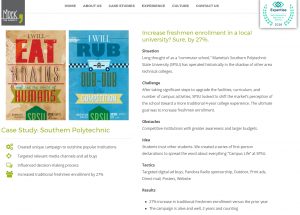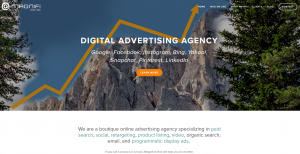There’s a saying around our office that if you look at a company’s website, and you can’t tell what they do, they are probably an agency. That ambiguity might be considered cheeky when the visitor knows who your agency is, but it spells certain doom for any agency looking to generate new business and leads through their website with prospects that are visiting them for the first time. While your website can be a fun, creative playground for your team, we need to remember that the primary goal of any good website is to convert prospects into new revenue.
The fact is 39% of people will stop engaging with a website if images won’t load or take too long to load. (Source: Adobe). What does this mean for your design? It means that we need to be conscious of where our visitors come from, what devices they are using to research you, and make sure that while your site is attractive, that attractiveness does not take away from the experience of finding out just what you do. For creatives (non-sales people) I understand the push back here. Nobody wants a plain or salesy feeling agency website, but we do want to be sure that it is a revenue generator, not a confusion generator.
The most successful agencies I’ve seen all have their past creative prioritized on their site, but it’s important to remember – it’s not the website itself that is the creative showcase. This is an important distinction, because when a prospect is visiting your website, they want to know:
A) Can you solve my problem? (clear and unique agency positioning on all pages)
In the case below, the positioning is very clearly and cuts directly to the problem they solve for their clients. Within 3 seconds, we know exactly who they are and what they do that is unique. 
B) Have you done it previously? (clear view of past creative and case studies)
Love this use of Case Studies – short and clear problem, solution, results. This is a great CTA target for any outgoing communication.

C) How do we get in contact? (contact page for key agency decision makers)
Multiple places to take action on this homepage, giving prospects a place to convert from anywhere on their site. They do a nice job of consistent positioning as well, along with vocalizing that immediately.

If we can simplify this online journey for our prospects, then we can greatly increase our chance of converting them from an anonymous visitor to a lead conversation. I would encourage you to sit down and go through this journey yourself with your current website. If you can’t find a truly unique positioning statement on each page, we need to edit. If you are not led quickly to outstanding results and work, then we need to edit. If you have to click a few times to find someone to contact, we need to edit.
This isn’t meant to say that your site should be boring and plain, or that you should just have random “contact us” buttons on every page like you are pushing a free trial. Be creative, show off your digital chops, but just be thoughtful in where and how you do that. If they have to sit through a five minute video, or go through an interactive hide and seek on the home page to find your agency’s past work, they will probably run rather than seek.









